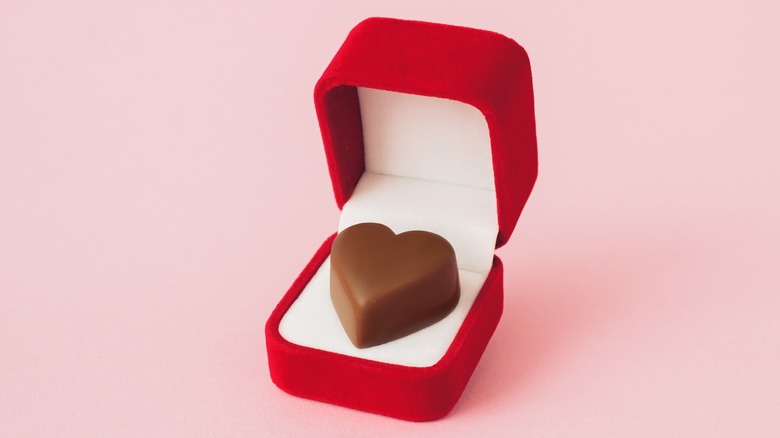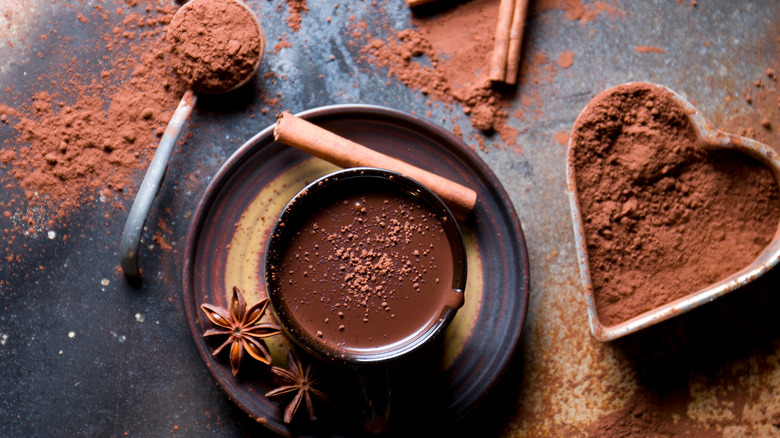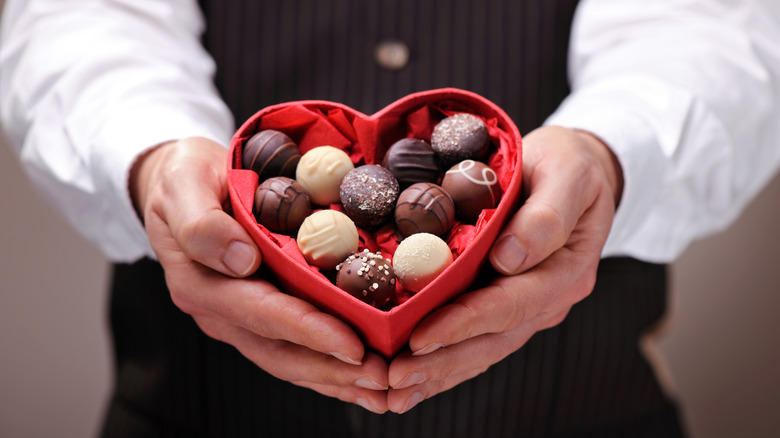How Chocolate Became A Symbol Of Love For Valentine's Day
Valentine's Day and chocolate have become almost synonymous, with 92% of Americans planning to celebrate the day with sweets, according to the National Confectioners Association. It makes you wonder where this connection came from. Does it all boil down to the strategic marketing efforts of "big chocolate" companies, or perhaps chocolate's rumored aphrodisiac qualities?
As sexy as chocolate is (especially when paired with a subtly spicy rum or bottle of wine) there may not be much science to support the latter theory. As nutrition expert Dr. Lauri Wright mentions in a Salon article, while certain foods can improve blood flow — which is important for getting in the mood — there isn't strong evidence that shows specific foods (chocolate included) improve sexual desire.
As it turns out, chocolate's association with love comes down to a mix of history and culture. To get to the bottom of it, we'll need to learn about ancient Maya weddings, chemistry, Victorian courtship, and an enterprising heir to the Cadbury chocolate fortune.
Chocolate's love connection
Long before it was molded into ruby chocolate bars and chocolate chips, chocolate was enjoyed as a drink. Its story begins with the Olmec civilization of the area we now know as southern Mexico, which cultivated the cacao plant and processed it into drinks as far back as 1500 BCE. Making cacao drinks was a tedious process, which included harvesting seeds, then drying, fermenting, and roasting them before making them into a drink with hot water, pepper, and cinnamon. The effort brought people together and made the drink (and beans) precious. People across Mesoamerica, including the Maya and Aztecs treasured it too, calling it the "food of the gods" and including it in ceremonies like marriages, hinting at the original link between chocolate and love.
In the 16th century, conquistador Hernán Cortés brought cacao to Spain after his time in South America, and the fascination with chocolate grew. Among its European admirers were royals, aristocrats, and none other than Casanova, who reportedly indulged in the sweetened drink to fuel his romantic escapades. The transformation from an elite beverage to a confectionery delight happened much later and was propelled by the invention of cocoa powder by Dutch chemist Conrad Van Houten in 1828, paving the way for Joseph Fry's creation of the first chocolate candy bar in 1847.
How chocolate became a V-day darling
The link between chocolate and Valentine's Day becomes clearer with an understanding of the holiday's origins. This mid-February occasion wasn't always about bouquets, cards, and heart-shaped boxes of chocolate — it likely originated as an ancient Roman Pagan festival called Lupercalia that included pairing off couples using a lottery system. St. Valentine's Day eventually replaced the celebration, most likely thanks to a fifth-century pope who preferred to use the day to commemorate St. Valentine.
People started sending notes and letters to their valentines as early as the 1500s, but things took off in the Victorian era. During this time, people were downright obsessed with the notion of courtly love and the romantic gestures that went with it (including gift-giving), which created fertile ground for a new product idea.
Enter Richard Cadbury, who introduced exquisite boxes of "eating chocolates," leveraging the excess cocoa butter from the production of cocoa powder. His ingeniously designed keepsake boxes, some heart-shaped, tapped into the Victorian ethos of love and romance, making chocolate an indispensable part of Valentine's Day celebrations.
Today, the tradition of gifting chocolate continues to flourish, with artisanal chocolates and personalized confections adding modern twists to this age-old token of affection. Through the ages, chocolate has proven to be more than just a sweet treat; it's a versatile symbol of love, luxury, and human connection, evolving yet steadfast in its role as the heart of Valentine's Day celebrations.


